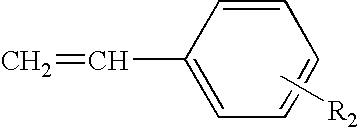Method for the modification of polyolefins
a polyolefin and polymer technology, applied in the direction of adhesives, adhesive types, graft polymer adhesives, etc., can solve the problems of reducing the overall desired mechanical properties, affecting the adhesion of polyolefins to paints, glues and inks, and achieving the level of polar molecules in the surface layer of the final article to achieve an acceptable paintability
- Summary
- Abstract
- Description
- Claims
- Application Information
AI Technical Summary
Benefits of technology
Problems solved by technology
Method used
Image
Examples
example 1
A high-flow polypropylene resin taken directly from the reactor as a powder was used. A quantity of 86 parts of this polypropylene resin was mixed with 2.5 parts of maleic anhydride and 1.5 parts of peroxide, and blended for 1 hour. The obtained mixture and 10 parts of R-TPO polymer were fed together to the extruder specified above. The temperature of the extruder was set at 200.degree. C., and the screw speed was adjusted to 150 rpm, which resulted in an output of 3 kg / h. This blend was extruded as strands which were cooled by water and chopped into granules in a conventional manner.
example 2
The procedure of Example 1 was followed, except that 84 parts of the polypropylene resin, 4.0 parts of maleic anhydride, 2 parts of the peroxide and 10 parts of the R-TPO polymer were used.
example 3
The procedure of Example 1 was followed, except that 64 parts of the polypropylene resin, 4 parts of maleic anhydride, 2 parts of the peroxide and 30 parts of R-TPO were used.
PUM
| Property | Measurement | Unit |
|---|---|---|
| Flow rate | aaaaa | aaaaa |
| Adhesion strength | aaaaa | aaaaa |
| Melting point | aaaaa | aaaaa |
Abstract
Description
Claims
Application Information
 Login to View More
Login to View More - R&D
- Intellectual Property
- Life Sciences
- Materials
- Tech Scout
- Unparalleled Data Quality
- Higher Quality Content
- 60% Fewer Hallucinations
Browse by: Latest US Patents, China's latest patents, Technical Efficacy Thesaurus, Application Domain, Technology Topic, Popular Technical Reports.
© 2025 PatSnap. All rights reserved.Legal|Privacy policy|Modern Slavery Act Transparency Statement|Sitemap|About US| Contact US: help@patsnap.com


